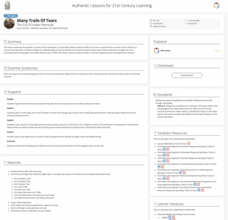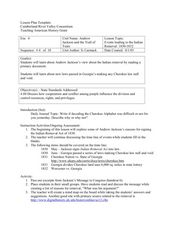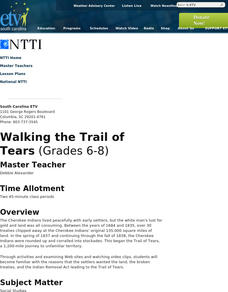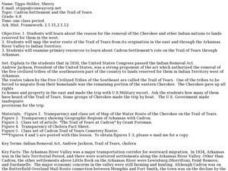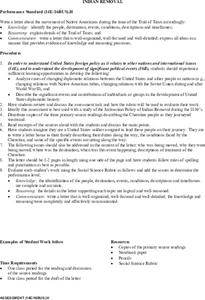K20 LEARN
Worcester v. Georgia: Cherokee Sovereignty and Actions of the U.S. Government
Young historians study the Supreme Court case "Worcester v. Georgia" and note instances where the Justices defended the sovereign rights of the Cherokee. They also examine the actions of President Andrew Jackson and the...
Curated OER
Jacksonian America and the Indian Removal Act of 1830
Students utilize primary sources to explore the national climate concerning Native American Indians during the Andrew Jackson administration. They are presented with opinions for and against the Indian Removial Act of 1830 as they...
K20 LEARN
Many Trails of Tears: The Era of Indian Removal
Cherokee, Chickasaw, Choctaw, Creek, and Seminole. All were forced off their ancestral lands in the southeastern United States as part of the Indian Removal Act of 1830. Young historians research the tribes' reactions to this removal and...
Curated OER
President Jackson, the Cherokee and Indian Removal
Students interpret historical evidence presented in primary and secondary resources. In this Indian Removal Act lesson, students examine the act and discuss the implications of moving the Cherokee. Students...
Curated OER
Events Leading to the Indian Removal 1830-1832
Learners consider the effects of Indian Removal on the Cherokee Nation. In this American history activity, students research Internet and print sources regarding the Indian Removal Act of 1830. Learners write short stories that detail...
Curated OER
Indian Removal: The Cherokees, Jackson, and the “Trail of Tears”
High schoolers examine executive power. For this Indian Removal lesson, students listen to their instructor present a lecture regarding the "Trail of Tears". High schoolers respond to discussion questions regarding the lecture.
Curated OER
Lesson Plan: The Math of Removal
Students consider the plight of those who walked the Trial of Tears. In this Indian Removal lesson, students compare statistics regarding Indian survival rates.
Alabama Department of Archives and History
Conflict in Alabama in the 1830s: Native Americans, Settlers, and Government
To better understand the Indian Removal Act of 1830, class members examine primary source documents including letters written by Alabama governors and the Cherokee chiefs. The instructional activity is part of a unit on the expansion of...
Curated OER
Removal of the Cherokees in Relation to Westward Expansion
Young scholars explore the concept of Manifest Destiny. In this Westward Expansion lesson,students examine primary and secondary, print and nonprint sources regarding the removal of the Cherokee.
Curated OER
Walking the Trail of Tears
Middle schoolers, through the use of examining video clips and Websites, become familiar with the reasons that the settlers wanted the land, broke treaties, and initiated the Indian Removal Act leading to the Trail of Tears.
Curated OER
Cadron Settlement and the Trail of Tears
Students examine the reason for removal of the Cherokee and other Indian nations. They map the water route of the Trail of Tears from its origination in the east and through the Arkansas River Valley to Indian Territory.
Curated OER
Trail of Tears
Students discover that the Indian Territory was comprised of many Indian tribes originating from many different locations. They distinguish between the Indian tribes in the Indian Territory.
Curated OER
How the West was Lost-The Trail of Tears
In this Native American history worksheet, students respond to 14 short answer questions about Cherokee removal polices and the Trail of Tears.
Curated OER
The Cherokee Removal
Eleventh graders examine the issue of Cherokee removal from the perspectives of Andrew Jackson, members of Congress, and members of the Cherokee nation. They adopt the perspectives and engage in debate over the issue of Cherokee removal.
Race Briges Studio
I am Indopino: Or, How to Answer the Question, "Who Are You?"
In our increasingly multi-ethnic society, many students find it difficult to identify themselves as belonging to any one ethnicity. Gene Tagaban, a Tlingit, Cherokee, Filipino offers his personal experiences with these questions in his...
Curated OER
Yours and My Trail of Tears
Students investigate the Trail of Tears. In this United States history lesson, students identify the reason for removing the Cherokee Nation and role play a modern day situation similar to the Indian Removal Act. Students reflect their...
Curated OER
Indian Removal
Learners investigate the historical events surrounding The Trail of Tears. They write a letter that identifies the people, destination, events, and descriptions surrounding the timeframe. Students provide a written summary of the history...
Curated OER
The Trail of Tears; Its Grief and Loss
Fifth graders trace the development and expansion of the US while studying the Trail of Tears. They examine the political factors and analyze the impact the Indian Removal Act had upon a society. They present a case for or against the...
Museum of Tolerance
The Pursuit of Democracy and Diversity: The Trial of Pro-Social Injustice in Historical Documents and Accounts
Class members investigate The Indian Removal Act of 1830, U.S. Theft of Mexican Territory Timeline, and President Abraham Lincoln’s letter to Horace Greeley, 1862, and then conduct a mock trial of each of these documents to determine...
Curated OER
Native Lands: Indians in Georgia , Losing Ground: Removal, 1802-1838
Students investigate the removal of the Creek Indians from Georgia. Students read the story of the Creek removal from Georgia, locate sites mentioned on a map, and create a related timeline. Students share their thoughts on the Creek...
Curated OER
Indian Removal
Fourth graders read The Trail of Tears and create a timeline to show the sequence of events that effected the Native American tribes during Andrew Jackson's presidency. In this Native American lesson plan, 4th graders discuss the...
State Bar of Texas
Worcester v. Georgia
Can the president of the United States defy the rulings of the Supreme Court? Students investigate the case of Worcester v. Georgia and the impact it had on society and, most importantly, Native Americans. Using a short video clip as...
Curated OER
Andrew Jackson and the Trail of Tears
Students examine the three historical portraits Andrew Jackson, iam Pitt and Portrait of a Boy for symbolism. They research Andrew Jackson's involvement in the Cherokee Indians' Trail of Tears in North Carolina, and compose a portrait.
Curated OER
Stop Action and Assess Alternatives
Students stop action and determine how history may have been altered. For this historical perspectives lesson, students consider how the Cherokee Removal, the Transcontinental Railroad, the Immigration Act of 1924, and the dropping of...


